Baby Lock BLSOG Ellisimo Gold User Manual [nl]
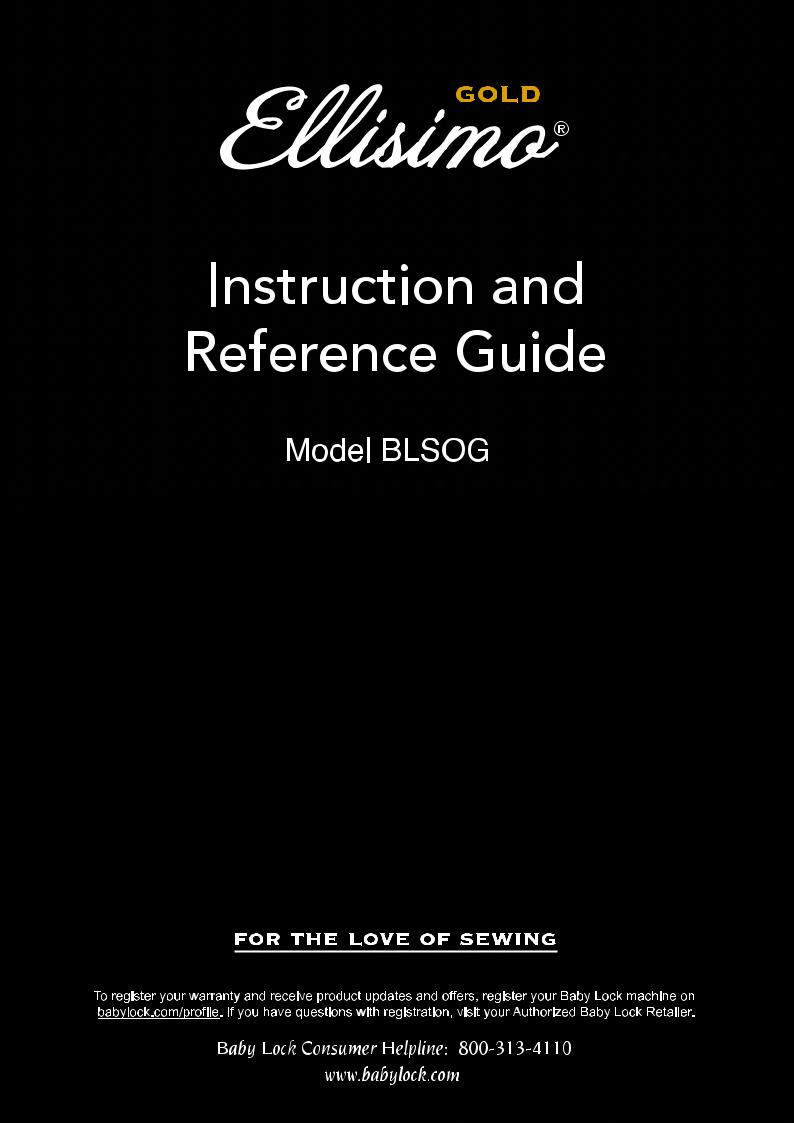
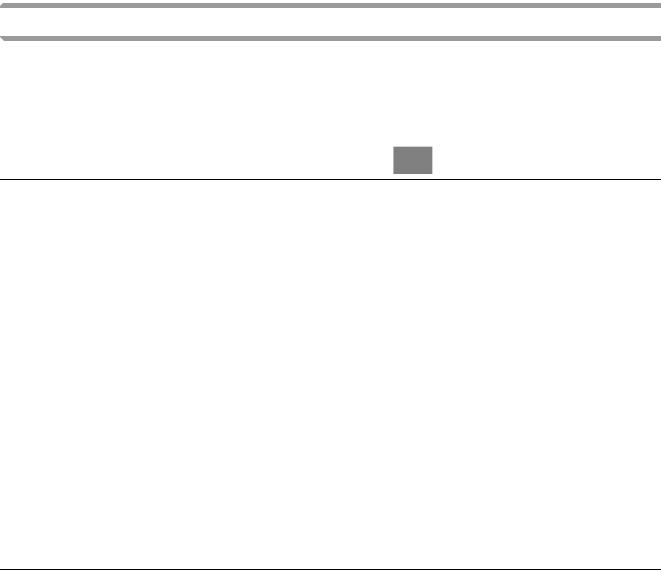
Trademarks
FlashFX® is a registered trademark of Datalight, Inc.
FlashFX® Copyright 1998-2007 Datalight, Inc.
U.S.Patent Office 5,860,082/6,260,156
FlashFX® Pro™ is a trademark of Datalight, Inc.
Datalight® is a registered trademark of Datalight, Inc.
Copyright 1989-2007 Datalight, Inc., All Rights Reserved
Video powered by Mobiclip™ encoding and playback technology.
IMPORTANT:
READ BEFORE DOWNLOADING, COPYING, INSTALLING OR USING.
By downloading, copying, installing or using the software you agree to this license. If you do not agree to this license, do not download, install, copy or use the software.
Intel License Agreement For Open Source Computer Vision Library
Copyright © 2000, Intel Corporation, all rights reserved. Third party copyrights are property of their respective owners.
Redistribution and use in source and binary forms, with or without modification, are permitted provided that the following conditions are met:
•Redistribution’s of source code must retain the above copyright notice, this list of conditions and the following disclaimer.
•Redistribution’s in binary form must reproduce the above copyright notice, this list of conditions and the following disclaimer in the documentation and/or other materials provided with the distribution.
•The name of Intel Corporation may not be used to endorse or promote products derived from this software without specific prior written permission.
This software is provided by the copyright holders and contributors “as is” and any express or implied warranties, including, but not limited to, the implied warranties of merchantability and fitness for a particular purpose are disclaimed. In no event shall Intel or contributors be liable for any direct, indirect, incidental, special, exemplary, or consequential damages (including, but not limited to, procurement of substitute goods or services; loss of use, data, or profits; or business interruption) however caused and on any theory of liability, whether in contract, strict liability, or tort (including negligence or otherwise) arising in any way out of the use of this software, even if advised of the possibility of such damage.
All information provided related to future Intel products and plans is preliminary and subject to change at any time, without notice.
Secure Digital (SD) Card is a registered trademark or a trademark of SD Card Association. CompactFlash is a registered trademark or a trademark of Sandisk Corporation.
Memory Stick is a registered trademark or a trademark of Sony Corporation. SmartMedia is a registered trademark or a trademark of Toshiba Corporation.
MultiMediaCard (MMC) is a registered trademark or a trademark of Infineon Technologies AG. xD-Picture Card is a registered trademark or a trademark of Fuji Photo Film Co. Ltd.
IBM is a registered trademark or a trademark of International Business Machines Corporation.
Microsoft, Windows and Windows Vista are registered trademarks or trademarks of Microsoft Corporation. “Adobe” and “Adobe Reader” are either registered trademarks or trademarks of Adobe Systems Incorporated in the United States and/or other countries.
Each company whose software title is mentioned in this manual has a Software License Agreement specific to its proprietary programs.
All other brands and product names mentioned in this manual are registered trademarks of their respective companies. However, the explanations for markings such as ® and ™ are not clearly described within the text.

INTRODUCTION
INTRODUCTION
Thank you for purchasing this embroidery and sewing machine. Before using this machine, carefully read the “IMPORTANT SAFETY INSTRUCTIONS”, and then study this manual for the correct operation of the various functions.
In addition, after you have finished reading this manual, store it where it can quickly be accessed for future reference.
IMPORTANT SAFETY INSTRUCTIONS
Please read these safety instructions before attempting to use the machine.
DANGER - To reduce the risk of electric shock
1Always unplug the machine from the electrical outlet immediately after using, when cleaning, when making any user servicing adjustments mentioned in this manual, or if you are leaving the machine unattended.
WARNING - To reduce the risk of burns, fire, electric shock, or injury to persons.
2Always unplug the machine from the electrical outlet when removing covers, or when making any adjustments mentioned in the instruction manual.
•To unplug the machine, switch the machine to the symbol “O” position to turn it off, then grasp the plug and pull it out of the electrical outlet. Do not pull on the cord.
•Plug the machine directly into the electrical outlet. Do not use an extension cord.
•Always unplug your machine if the power is cut.
3Never operate this machine if it has a damaged cord or plug, if it is not working properly, if it has been dropped
or damaged, or water is spilled on the unit. Return the machine to the nearest authorized retailer for examination, repair, electrical or mechanical adjustment.
•While the machine is stored or in use if you notice anything unusual, such as an odor, heat, discoloration or deformation, stop using the machine immediately and unplug the power cord.
•When transporting the sewing machine, be sure to carry it by its handle. Lifting the sewing machine by any other part may damage the machine or result in the machine falling, which could cause injuries.
•When lifting the sewing machine, be careful not to make any sudden or careless movements, otherwise you may injure your back or knees.
4Always keep your work area clear:
•Never operate the machine with any air openings blocked. Keep ventilation openings of the sewing machine and foot control free from the build up of lint, dust, and loose cloth.
•Do not store objects on the foot controller.
•Do not use extension cords. Plug the machine directly into the electrical outlet.
•Never drop or insert any object into any opening.
•Do not operate where aerosol (spray) products are being used or where oxygen is being administered.
•Do not use the machine near a heat source, such as a stove or iron; otherwise, the machine, power cord or garment being sewn may ignite, resulting in fire or an electric shock.
•Do not place this sewing machine on an unstable surface, such as an unsteady or slanted table, otherwise the sewing machine may fall, resulting in injuries.
1

IMPORTANT SAFETY INSTRUCTIONS
5Special care is required when sewing:
•Always pay close attention to the needle. Do not use bent or damaged needles.
•Keep fingers away from all moving parts. Special care is required around the machine needle.
•Switch the sewing machine to the symbol “O” position to turn it off when making any adjustments in the needle area.
•Do not use a damaged or incorrect needle plate, as it could cause the needle to break.
•Do not push or pull the fabric when sewing, and follow careful instruction when free motion stitching so that you do not deflect the needle and cause it to break.
6This machine is not a toy:
•Your close attention is necessary when the machine is used by or near children.
•The plastic bag that this sewing machine was supplied in should be kept out of the reach of children or disposed of. Never allow children to play with the bag due to the danger of suffocation.
•Do not use outdoors.
7For a longer service life:
•When storing this machine, avoid direct sunlight and high humidity locations. Do not use or store the machine near a space heater, iron, halogen lamp, or other hot objects.
•Use only neutral soaps or detergents to clean the case. Benzene, thinner, and scouring powders can damage the case and machine, and should never be used.
•Always consult the operation manual when replacing or installing any assemblies, the presser feet, needle, or other parts to assure correct installation.
8For repair or adjustment:
•If the light unit is damaged, it must be replaced by an authorized retailer.
•In the event a malfunction occurs or adjustment is required, first follow the troubleshooting table in the back of the operation manual to inspect and adjust the machine yourself. If the problem persists, please consult your local authorized Baby Lock retailer.
Use this machine only for its intended use as described in the manual.
Use accessories recommended by the manufacturer as contained in this manual.
Use only the interface cable (USB cable) included with this machine.
Use only the USB mouse included with this machine.
Use only the pen tablet included with this machine.
The contents of this manual and specifications of this product are subject to change without notice. For additional product information and updates, visit our website at www.babylock.com
SAVE THESE INSTRUCTIONS
This machine is intended for household use.
This appliance is not intended for use by persons (including children) with reduced physical, sensory or mental capabilities, or lack of experience and knowledge, unless they have been given supervision or instruction concerning use of the appliance by a person responsible for their safety. Children should be supervised to ensure that they do not play with the appliance.
2

IMPORTANT SAFETY INSTRUCTIONS
FOR USERS IN THE UK, EIRE, MALTA
AND CYPRUS ONLY
IMPORTANT
•In the event of replacing the plug fuse, use a fuse approved by ASTA to BS 1362, i.e. carrying the  mark, rating as marked on plug.
mark, rating as marked on plug.
•Always replace the fuse cover. Never use plugs with the fuse cover omitted.
•If the available electrical outlet is not suitable for the plug supplied with this equipment, you should contact your authorized retailer to obtain the correct lead.
Federal Communications Commission (FCC)
Declaration of Conformity (For USA Only)
Responsible Party: |
Tacony Corporation |
|
1760 Gilsinn Lane, |
|
Fenton, Missouri 63026 USA |
declares that the product |
|
Product Name: |
Baby Lock Sewing Machine |
Model Number: |
BLSOG |
This device complies with Part 15 of the FCC Rules. Operation is subject to the following two conditions: (1) this device may not cause harmful interference, and (2) this device must accept any interference received, including interference that may cause undesired operation.
This equipment has been tested and found to comply with the limits for a Class B digital device, pursuant to Part 15 of the FCC Rules. These limits are designed to provide reasonable protection against harmful interference in a residential installation. This equipment generates, uses, and can radiate radio frequency energy and, if not installed and used in accordance with the instructions, may cause harmful interference to radio communications. However, there is no guarantee that interference will not occur in a particular installation. If this equipment does cause harmful interference to radio or television reception, which can be determined by turning the equipment off and on, the user is encouraged to try to correct the interference by one or more of the following measures:
•Reorient or relocate the receiving antenna.
•Increase the separation between the equipment and receiver.
•Connect the equipment into an outlet on a circuit different from that to which the receiver is connected.
•Consult the retailer or an experienced radio/TV technician for help.
•The included interface cable should be used in order to ensure compliance with the limits for a Class B digital device.
•Changes or modifications not expressly approved by Tacony Corporation could void the user’s authority to operate the equipment.
3
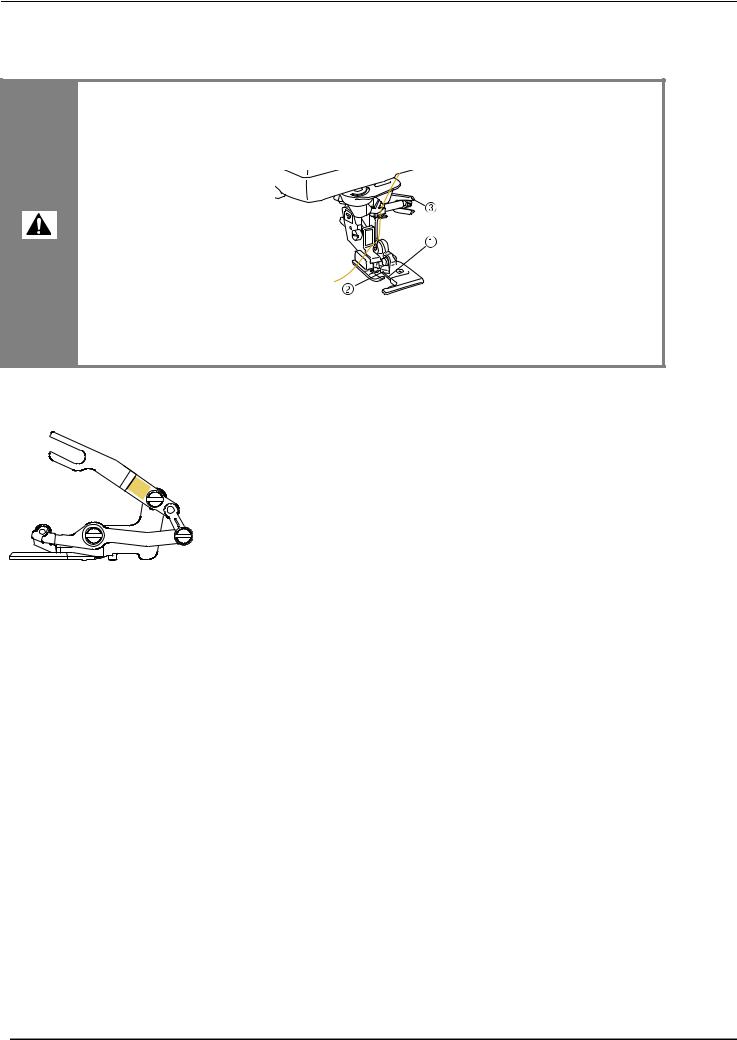
IMPORTANT SAFETY INSTRUCTIONS
WARNING LABEL
The following warning label is on the included side cutter. Be sure to observe the precaution.
 CAUTION
CAUTION
•When using the side cutter, sew between low and mid-speed and do not touch the knives or operation lever of the side cutter while sewing to avoid equipment damage or injury.
aGuide plate (lower knife)
bUpper knife
cOperation lever
Label location
4

IMPORTANT SAFETY INSTRUCTIONS
5
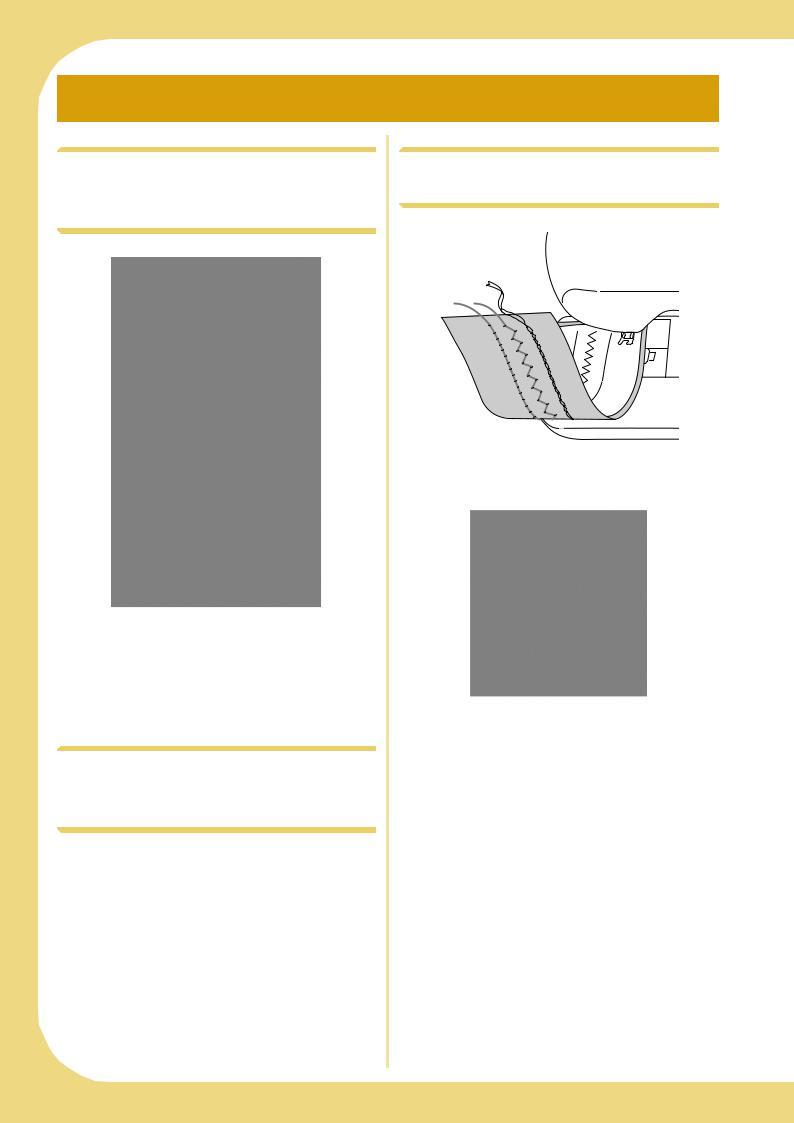
OUTSTANDING FEATURES
Display the Fabric While
Aligning the Embroidering
Position
The fabric hooped in the embroidery frame can be displayed on the LCD so that the embroidery position can be easily aligned.
This feature allows you to easily combine patterns while checking the final image.
See “Display the Fabric While Aligning the Embroidering Position” on page 211.
Change the Pattern Size While
Maintaining the Desired Thread
Density (Stitch Recalculator)
In the embroidery edit screen, the size of the pattern can be changed while the desired thread density is maintained.
With this function, the pattern will be enlarged or reduced at a larger ratio than with normal pattern resizing.
See “Changing the Pattern Size While Maintaining the Desired Thread Density (Stitch Recalculator)” on page 270.
Expand Your Creativity With
Bobbin Work
Example with decorative stitches
You can create bobbin work, which gives a threedimensional appearance to the surface of the fabric, by winding the bobbin with heavy weight thread or ribbon too thick to be fed through the sewing machine needle and sewing on the wrong side of the fabric.
Bobbin work is sewn using the special bobbin case (gray) included with this machine.
See “How to Create Bobbin Work” on page 307.
6

Find New Color Schemes With
the Color Visualizer Function
With the Color Visualizer function, the machine suggests new color schemes for the embroidery pattern that you have selected. After you select the desired effect from one of the four available color schemes (“RANDOM”, “VIVID”, “GRADIENT” and “SOFT”) the sample for the selected effect is displayed.
See “Find New Color Schemes With the Color Visualizer Function” on page 283.
Create Patterns With On Screen
Designer™
Any image that you draw in the LCD screen area of your machine can immediately become an embroidery pattern. Specify colors and sewing settings as you desire.
Compose embroidery from children’s drawings or of your signature to add to your original artwork. This is a function that everyone will enjoy using.
The included pen tablet makes this function even easier to use.
Refer to the instruction manual (PDF format) stored in the On Screen Designer™ CD.
Easily Perform On Screen
Designer™ Operations With the
Included Pen Tablet
The included pen tablet can be used to perform On Screen Designer™ operations effectively, along with normal screen operations. Since the range of operation with the pen tablet is wider than the machine’s LCD screen, you can easily perform intricate procedures.
See “Using the Pen Tablet” on page 23 and “Using the Pen Tablet” on page 34.
7

WHAT YOU CAN DO WITH THIS MACHINE
Getting Ready
To learn the operation of the principal parts and the screens
Chapter 1
Page 25
Utility Stitches
Pre-programmed with more than 100 frequently used stitches
Chapter 3
Page 89
Embroidery
Maximum 30 cm × 20 cm (approx. 12 × 8 inches) for large embroidery designs
Chapter 5
Page 185
How to Create Bobbin Work
To learn how to create bobbin work
Chapter 7
Page 307
Sewing Basics
To learn how to prepare for sewing and basic sewing operations
Chapter 2
Page 71
Character/Decorative
Stitches
The variety of stitches widen your creativity
Chapter 4
Page 155
Embroidery Edit
Designs can be combined, rotated or enlarged
Chapter 6
Page 263
Appendix
Caring for your machine and dealing with errors and malfunctions
Chapter 8
Page 325
8
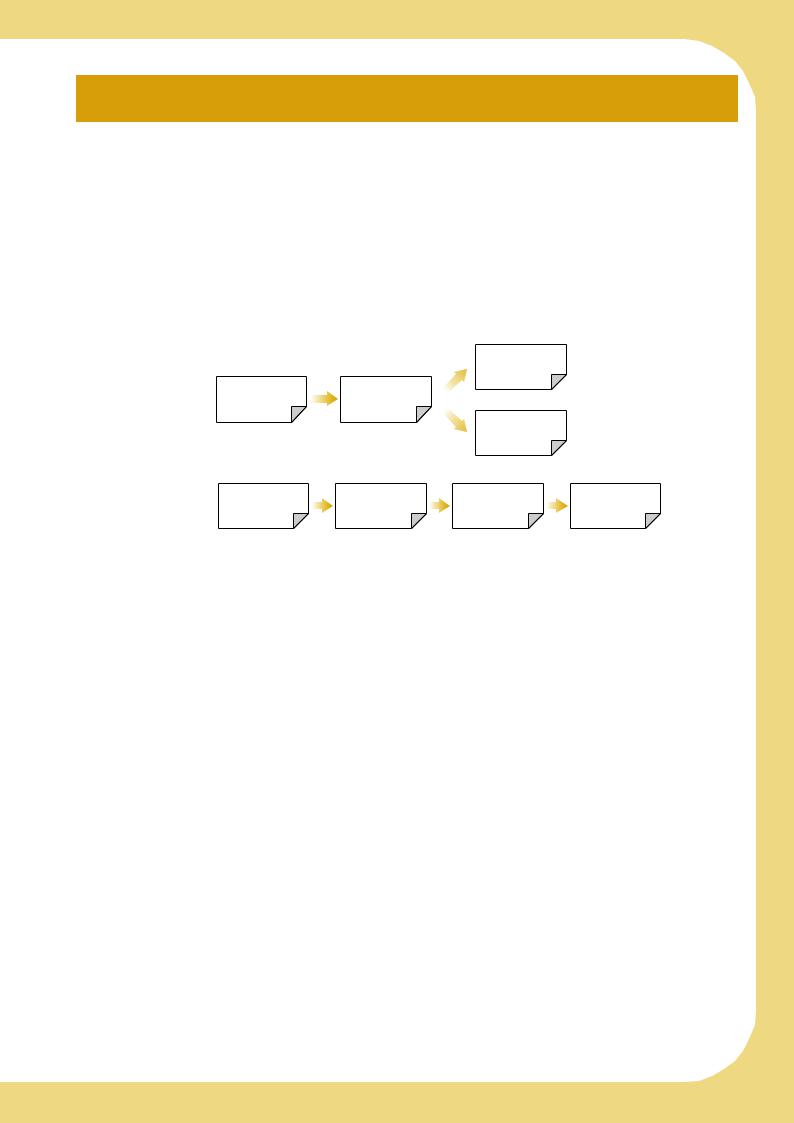
HOW TO USE THIS MANUAL
Chapter 1 and Chapter 2 explain your sewing machine’s basic operation procedures for someone who is using the sewing machine for the first time. If you want to sew utility stitches or character/ decorative stitches, read Chapter 1 and Chapter 2, then go on to Chapter 3 (Utility Stitches) or Chapter 4 (Character/ Decorative Stitches).
When you are ready to begin using the embroidery function after reading Chapter 1 and Chapter 2, proceed to Chapter 5 (Embroidery). Once you understand the steps explained in Chapter 5, go on to Chapter 6 (Embroidery Edit) for an explanation about the embroidery edit functions.
In the screens appearing in the step-by-step instructions, the parts referred to in the operations are marked
with  . Compare the screen in the directions with the actual screen, and carry out the operation.
. Compare the screen in the directions with the actual screen, and carry out the operation.
If, while using the machine, you experience something you do not understand, or there is a function you would like to know more about, refer to the index at the back of the operation manual in conjunction with the table of contents to find the section of the manual you should refer to.
|
|
|
Chapter 3 |
|
To sew utility stitches |
|
|
|
|
To sew character or |
Chapter 1 |
Chapter 2 |
|
|
decorative stitches |
|
|
|
|
|
|
|
Chapter 4 |
|
To do machine |
Chapter 1 |
Chapter 2 |
Chapter 5 |
Chapter 6 |
embroidery |
9
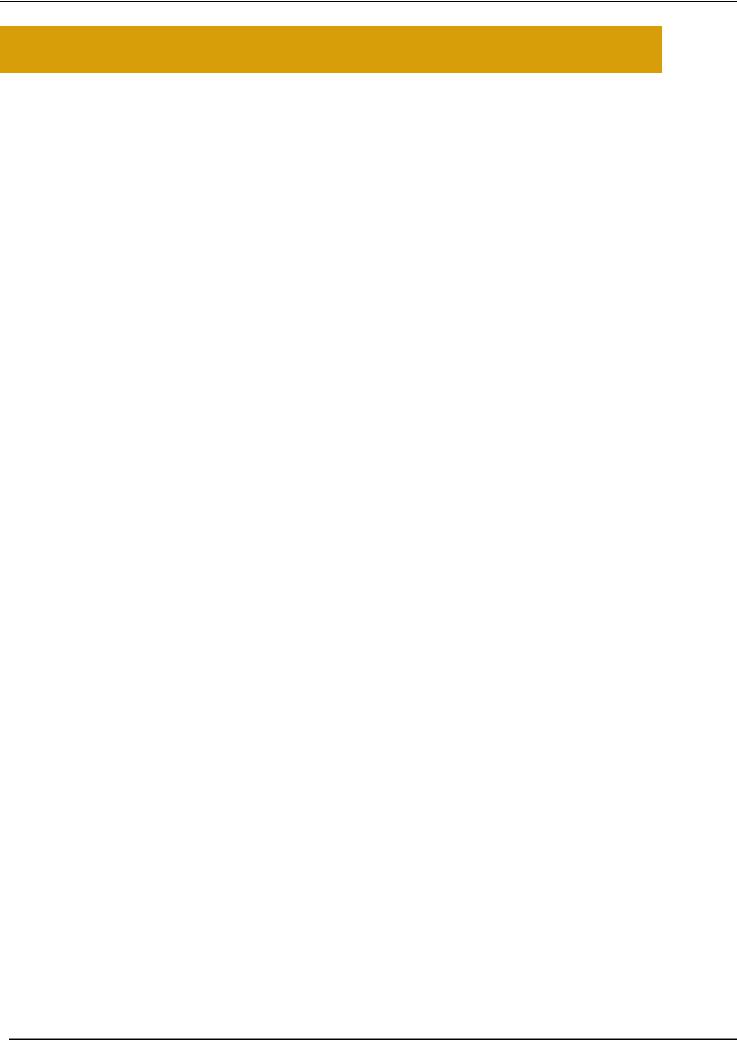
CONTENTS
CONTENTS |
|
INTRODUCTION.................................................. |
1 |
IMPORTANT SAFETY INSTRUCTIONS ................. |
1 |
OUTSTANDING FEATURES .................................. |
6 |
WHAT YOU CAN DO WITH THIS MACHINE ...... |
8 |
HOW TO USE THIS MANUAL .............................. |
9 |
NAMES OF MACHINE PARTS AND THEIR |
|
FUNCTIONS ......................................................... |
13 |
Machine................................................................................ |
13 |
Needle and Presser Foot Section ........................................... |
14 |
Embroidery Unit.................................................................... |
15 |
Operation Buttons ................................................................. |
15 |
Using the Flat Bed Attachment .............................................. |
16 |
Using the Accessory Case...................................................... |
16 |
Using the Embroidery Unit Carrying Case ............................. |
17 |
Included Accessories............................................................. |
17 |
Options ................................................................................. |
20 |
Using the Spool Stand ........................................................... |
21 |
Using the Pen Tablet ............................................................. |
23 |
Chapter 1 Getting Ready |
25 |
TURNING THE MACHINE ON/OFF.................... |
26 |
LCD SCREEN ....................................................... |
28 |
USB Connectivity .................................................................. |
32 |
Using the Machine Setting Mode Key ................................... |
35 |
Using the Sewing Machine Help Key ................................... |
44 |
Using the Operation Guide Function..................................... |
45 |
Using the Sewing Guide Function ......................................... |
46 |
Using the Pattern Explanation Function ................................. |
47 |
LOWER THREADING.......................................... |
48 |
Winding the Bobbin .............................................................. |
48 |
Setting the Bobbin ................................................................. |
54 |
Pulling Up the Bobbin Thread ............................................... |
55 |
UPPER THREADING............................................ |
57 |
Upper Threading ................................................................... |
57 |
Using the Twin Needle Mode................................................ |
60 |
Using the Spool Stand ........................................................... |
63 |
Using Threads that Unwind Quickly ..................................... |
64 |
CHANGING THE PRESSER FOOT ....................... |
65 |
Removing the Presser Foot .................................................... |
65 |
Attaching the Presser Foot ..................................................... |
65 |
Attaching the Walking Foot ................................................... |
66 |
CHANGING THE NEEDLE................................... |
67 |
About the Needle .................................................................. |
69 |
Fabric/Thread/Needle Combinations ..................................... |
69 |
Chapter 2 Sewing Basics |
71 |
SEWING .............................................................. |
72 |
Sewing a Stitch...................................................................... |
72 |
Sewing Reinforcement Stitches.............................................. |
74 |
Sewing Curves....................................................................... |
74 |
Changing Sewing Direction................................................... |
75 |
Sewing Heavyweight Fabrics................................................. |
75 |
Sewing Hook-and-Loop Fastener........................................... |
76 |
Sewing Lightweight Fabrics ................................................... |
76 |
Sewing Stretch Fabrics........................................................... |
77 |
STITCH SETTINGS............................................... |
78 |
Setting the Stitch Width ......................................................... |
78 |
Setting the Stitch Length ........................................................ |
79 |
Setting the Thread Tension .................................................... |
79 |
USEFUL FUNCTIONS.......................................... |
81 |
Automatic Reinforcement Stitching ....................................... |
81 |
Automatic Thread Cutting ..................................................... |
82 |
Using the Knee Lifter ............................................................. |
83 |
Pivoting................................................................................. |
84 |
Automatic Fabric Sensor System (Automatic Presser Foot |
|
Pressure)................................................................................ |
85 |
Needle Position – Stitch Placement....................................... |
86 |
Locking the Screen ............................................................... |
86 |
Checking the Needle Location in the Screen......................... |
87 |
Chapter 3 Utility Stitches |
89 |
SELECTING UTILITY STITCHES .......................... |
90 |
Selecting a Stitch .................................................................. |
91 |
Saving Your Stitch Settings.................................................... |
92 |
SEWING THE STITCHES ..................................... |
94 |
Straight Stitches .................................................................... |
94 |
Dart Seam............................................................................. |
99 |
Gathering ............................................................................. |
99 |
Flat Fell Seam ..................................................................... |
100 |
Pintuck ............................................................................... |
101 |
Zigzag Stitches.................................................................... |
102 |
Elastic Zigzag Stitches......................................................... |
104 |
Overcasting ........................................................................ |
105 |
Quilting .............................................................................. |
110 |
Blind Hem Stitches ............................................................. |
122 |
Appliqué............................................................................. |
125 |
Shelltuck Stitches................................................................ |
126 |
Scallop Stitches................................................................... |
127 |
Crazy Quilting .................................................................... |
127 |
Smocking Stitches............................................................... |
128 |
Fagoting.............................................................................. |
128 |
Tape or Elastic Attaching .................................................... |
129 |
Heirloom ............................................................................ |
130 |
One-step Buttonholes ......................................................... |
132 |
Four-step Buttonholes ......................................................... |
136 |
Bar Tacks............................................................................ |
140 |
Button Sewing .................................................................... |
142 |
Eyelet.................................................................................. |
144 |
Multi-directional Sewing (Straight Stitch and Zigzag Stitch) ..... |
145 |
Zipper Insertion .................................................................. |
146 |
Edge Sewing ....................................................................... |
148 |
Chapter 4 Character/Decorative Stitches 155
SELECTING STITCH PATTERNS ........................ |
156 |
Selecting Decorative Stitch Patterns/7mm Decorative Stitch |
|
Patterns/Satin Stitch Patterns/7mm Satin Stitch Patterns/ |
|
Cross Stitch/Utility Decorative Stitch Patterns ..................... |
158 |
Alphabet Characters ........................................................... |
158 |
SEWING STITCH PATTERNS ............................ |
161 |
Sewing Attractive Finishes .................................................. |
161 |
Basic Sewing ...................................................................... |
161 |
Making Adjustments ........................................................... |
162 |
EDITING STITCH PATTERNS............................ |
164 |
Changing the Size............................................................... |
166 |
Changing the Length (for 7mm Satin Stitch Patterns Only) ....... |
166 |
Creating a Vertical Mirror Image......................................... |
166 |
Creating a Horizontal Mirror Image .................................... |
167 |
Sewing a Pattern Continuously ........................................... |
167 |
Changing Thread Density (for Satin Stitch Patterns Only) .... |
167 |
Returning to the Beginning of the Pattern............................ |
168 |
Checking the Image ............................................................ |
168 |
COMBINING STITCH PATTERNS..................... |
170 |
Before Combining............................................................... |
170 |
Combining Various Stitch Patterns ...................................... |
170 |
Combining Large and Small Stitch Patterns ......................... |
171 |
Combining Horizontal Mirror Image Stitch Patterns ............ |
172 |
Combining Stitch Patterns of Different Length..................... |
173 |
Making Step Stitch Patterns |
|
(for 7mm Satin Stitch Patterns Only) ................................... |
174 |
USING THE MEMORY FUNCTION .................. |
176 |
Stitch Data Precautions....................................................... |
176 |
Saving Stitch Patterns in the Machine’s Memory ................. |
177 |
Saving Stitch Patterns to USB Media ................................... |
178 |
Saving Stitch Patterns in the Computer................................ |
179 |
10
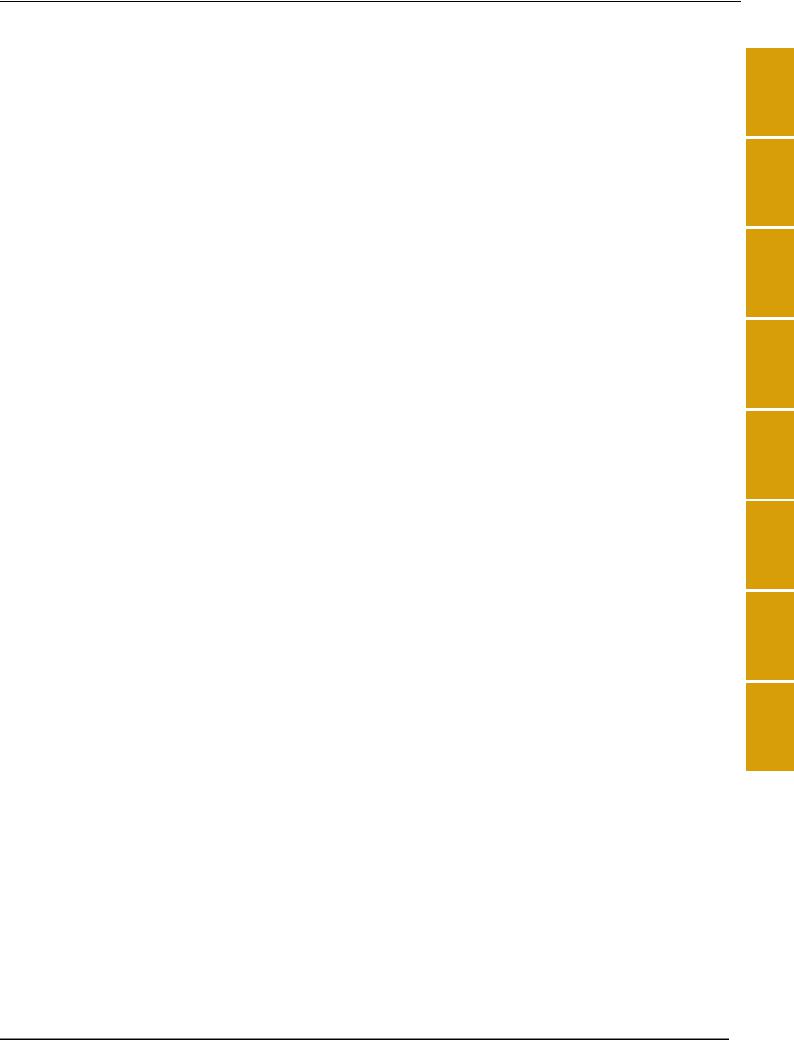
CONTENTS
Retrieving Stitch Patterns from the Machine’s Memory........ |
180 |
Recalling from USB Media .................................................. |
181 |
Recalling from the Computer .............................................. |
182 |
Chapter 5 Embroidery |
185 |
BEFORE EMBROIDERING ................................. |
186 |
Embroidery Step by Step ..................................................... |
186 |
Attaching Embroidery Foot “W” .......................................... |
187 |
Attaching the Embroidery Unit ............................................ |
188 |
SELECTING PATTERNS...................................... |
190 |
Selecting Embroidery Patterns/Baby Lock “Exclusives”/Greek |
|
Alphabet Patterns/Floral Alphabet Patterns/Utility Embroidery |
|
Patterns............................................................................... |
193 |
Selecting Alphabet Character Patterns ................................. |
194 |
Selecting Frame Patterns ..................................................... |
196 |
Selecting Patterns from Embroidery Cards ........................... |
197 |
Selecting Patterns from USB Media/Computer..................... |
197 |
VIEWING THE SEWING SCREEN...................... |
198 |
PREPARING THE FABRIC.................................. |
200 |
Attaching Iron-on Stabilizers (Backing) to the Fabric ........... |
200 |
Hooping the Fabric in the Embroidery Frame ...................... |
202 |
Embroidering Small Fabrics or Fabric Edges ........................ |
205 |
ATTACHING THE EMBROIDERY FRAME.......... |
206 |
CONFIRMING THE PATTERN POSITION......... |
208 |
Aligning the Embroidering Position Using the Built-In |
|
Camera ............................................................................... |
208 |
Display the Fabric While Aligning the Embroidering |
|
Position............................................................................... |
211 |
Using the Built-In Camera to Align the Embroidering |
|
Position............................................................................... |
213 |
Checking the Pattern Position ............................................. |
216 |
Previewing the Completed Pattern ...................................... |
217 |
SEWING AN EMBROIDERY PATTERN .............. |
218 |
Sewing Attractive Finishes................................................... |
218 |
Using Prewound Bobbins.................................................... |
219 |
Sewing Embroidery Patterns ................................................ |
220 |
Sewing Embroidery Patterns Which Use Appliqué .............. |
221 |
PRINT AND STITCH (COMBINING EMBROIDERY |
|
PATTERNS AND PRINTED DESIGNS) .............. |
223 |
Selecting a Pattern .............................................................. |
224 |
Outputting the Background Image and Positioning Image ... |
225 |
Printing the Background and Embroidery Position Sheet ..... |
226 |
Sewing Embroidery Patterns ................................................ |
227 |
ADJUSTMENTS DURING THE EMBROIDERY |
|
PROCESS ............................................................ |
229 |
If the Bobbin Runs Out of Thread........................................ |
229 |
If the Thread Breaks During Sewing .................................... |
230 |
Restarting from the Beginning ............................................. |
231 |
Resuming Embroidery After Turning Off the Power ............. |
231 |
MAKING EMBROIDERY ADJUSTMENTS .......... |
233 |
Adjusting Thread Tension ................................................... |
233 |
Adjusting the Alternate Bobbin Case (with No Color on the |
|
Screw)................................................................................. |
234 |
Using the Automatic Thread Cutting Function |
|
(END COLOR TRIM) ........................................................... |
235 |
Using the Thread Trimming Function (JUMP STITCH TRIM) ..... |
236 |
Adjusting the Embroidery Speed ......................................... |
237 |
Changing the Thread Color Display .................................... |
237 |
Changing the Embroidery Frame Display ............................ |
238 |
REVISING THE PATTERN .................................. |
240 |
Moving the Pattern.............................................................. |
240 |
Aligning the Pattern and the Needle.................................... |
240 |
Changing the Size of the Pattern ......................................... |
241 |
Rotating the Pattern............................................................. |
242 |
Creating a Horizontal Mirror Image .................................... |
243 |
Changing the Density (Alphabet Character and Frame |
|
Patterns Only) ..................................................................... |
244 |
Changing the Colors of Alphabet Character Patterns ........... |
245 |
Embroidering Linked Characters ......................................... |
245 |
Uninterrupted Embroidering (Using a Single Color)............. |
248 |
USING THE MEMORY FUNCTION................... |
249 |
Embroidery Data Precautions .............................................. |
249 |
Saving Embroidery Patterns in the Machine’s Memory ........ |
251 |
Saving Embroidery Patterns to USB Media........................... |
252 |
Saving Embroidery Patterns in the Computer ....................... |
253 |
Retrieving Patterns from the Machine’s Memory.................. |
254 |
Recalling from USB Media .................................................. |
255 |
Recalling from the Computer............................................... |
256 |
EMBROIDERY APPLICATIONS......................... |
258 |
Using a Frame Pattern to Make an Appliqué (1)................... |
258 |
Using a Frame Pattern to Make an Appliqué (2)................... |
259 |
Sewing Split Embroidery Patterns ........................................ |
261 |
Chapter 6 Embroidery Edit |
263 |
EXPLANATION OF FUNCTIONS...................... |
264 |
SELECTING PATTERNS TO EDIT ...................... |
265 |
Selecting Embroidery Patterns/Baby Lock “Exclusives”/Greek |
|
Alphabet Patterns/Floral Alphabet Patterns/Utility Embroidery |
|
Patterns/Frame Patterns ....................................................... |
266 |
Selecting Alphabet Character Patterns ................................. |
266 |
EDITING PATTERNS......................................... |
268 |
Moving the Pattern .............................................................. |
270 |
Rotating the Pattern ............................................................. |
270 |
Changing the Size of the Pattern.......................................... |
270 |
Changing the Pattern Size While Maintaining the Desired |
|
Thread Density (Stitch Recalculator).................................... |
270 |
Deleting the Pattern............................................................. |
272 |
Displaying Patterns in the Screen Magnified by 200% ......... |
272 |
Changing the Configuration of Alphabet Character Patterns ..... |
273 |
Changing Alphabet Character Spacing ................................ |
273 |
Reducing Character Spacing................................................ |
274 |
Separating Combined Character Patterns............................. |
275 |
Changing the Color of Each Alphabet Character in a Pattern .... |
276 |
Embroidering Linked Characters.......................................... |
277 |
Changing the Thread Color ................................................. |
277 |
Creating a Custom Thread Table ......................................... |
278 |
Choosing a Color from the Custom Thread Table ................ |
282 |
Find New Color Schemes With the Color Visualizer |
|
Function .............................................................................. |
283 |
Designing Repeated Patterns ............................................... |
285 |
Embroidering the Pattern Repeatedly ................................... |
290 |
Duplicating a Pattern........................................................... |
293 |
After Editing ........................................................................ |
293 |
COMBINING PATTERNS.................................. |
294 |
Editing Combined Patterns .................................................. |
294 |
Sewing Combined Patterns.................................................. |
297 |
VARIOUS EMBROIDERING FUNCTIONS........ |
298 |
Uninterrupted Embroidering (Using a Single Color) ............. |
298 |
Basting Embroidery ............................................................. |
298 |
Creating an Appliqué Piece ................................................. |
299 |
USING THE MEMORY FUNCTION .................. |
305 |
PRINT AND STITCH (COMBINING EMBROIDERY |
|
PATTERNS AND PRINTED DESIGNS) .............. |
305 |
Chapter 7 How to Create Bobbin Work |
307 |
ABOUT BOBBIN WORK................................... |
308 |
PREPARING FOR BOBBIN WORK.................... |
309 |
Required Materials .............................................................. |
309 |
Upper Threading ................................................................. |
310 |
Preparing the Bobbin Thread ............................................... |
310 |
CREATING BOBBIN WORK (SEWING)............ |
314 |
Positioning the Fabric and Sewing ....................................... |
314 |
Bobbin Work Free Motion Sewing....................................... |
317 |
CREATING BOBBIN WORK (EMBROIDERY) ... |
318 |
Selecting the Pattern............................................................ |
318 |
Start Embroidering............................................................... |
320 |
ADJUSTING THE THREAD TENSION............... |
322 |
TROUBLESHOOTING ...................................... |
323 |
Chapter 8 Appendix |
325 |
CARE AND MAINTENANCE ............................. |
326 |
1
2
3
4
5
6
7
8
11

CONTENTS
Restrictions on oiling........................................................... |
326 |
Precautions on storing the machine..................................... |
326 |
Cleaning the LCD Screen .................................................... |
326 |
Cleaning the Machine Casing.............................................. |
326 |
Cleaning the Race ............................................................... |
326 |
Cleaning the Bobbin Case ................................................... |
328 |
Cleaning the Cutter in the Bobbin Case Area....................... |
329 |
About the Maintenance Message......................................... |
329 |
ADJUSTING THE SCREEN................................. |
330 |
Adjusting the Brightness of the Screen Display .................... |
330 |
Touch Panel is Malfunctioning ............................................ |
330 |
TROUBLESHOOTING....................................... |
331 |
ERROR MESSAGES ............................................ |
336 |
SPECIFICATIONS .............................................. |
344 |
UPGRADING YOUR MACHINE’S SOFTWARE ....... |
345 |
Upgrade Procedure Using USB Media................................. |
345 |
Upgrade Procedure Using Computer................................... |
346 |
STITCH SETTING CHART.................................. |
347 |
INDEX ............................................................... |
356 |
12
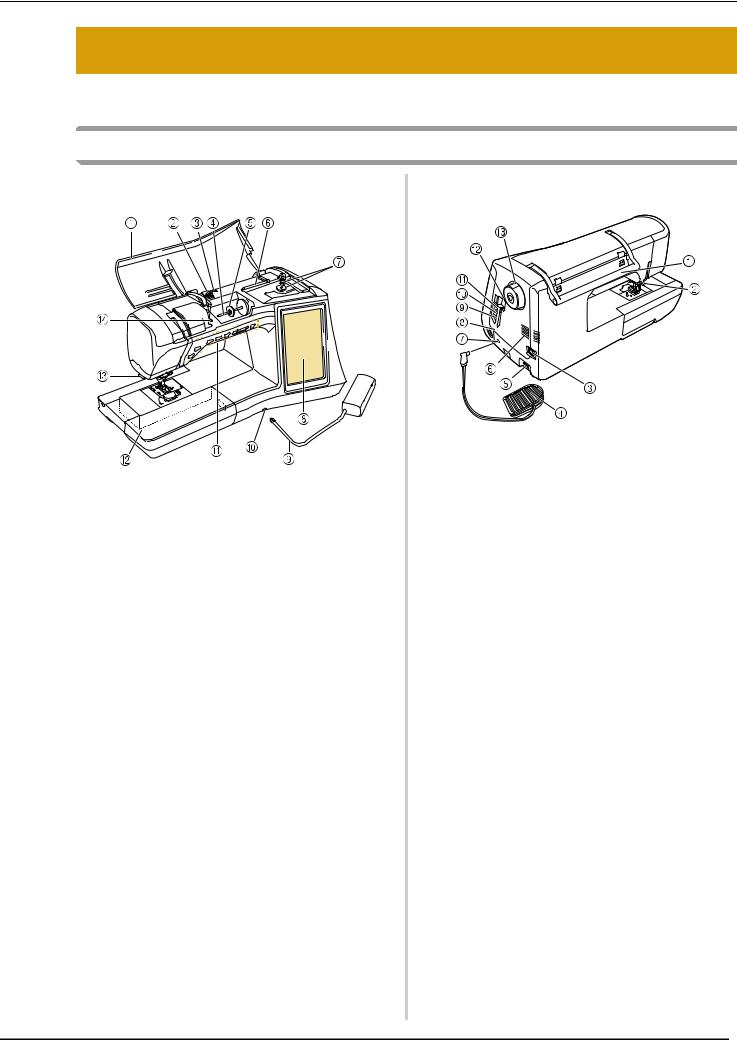
NAMES OF MACHINE PARTS AND THEIR FUNCTIONS
NAMES OF MACHINE PARTS AND THEIR FUNCTIONS
The names of the various parts of the sewing machine and their functions are described below. Before using the sewing machine, carefully read these descriptions to learn the names of the machine parts.
Machine
■ Front View
aTop cover
Open the top cover to thread the machine and wind the bobbin.
bPre-tension disk
Pass the thread around the pre-tension disk when winding the bobbin thread. (page 48)
cThread guide for bobbin winding
Pass the thread through this thread guide when winding the bobbin thread. (page 48)
dSpool pin
Place a spool of thread on the spool pin. (page 57)
eSpool cap
Use the spool cap to hold the spool of thread in place. (page 57)
fSupplemental spool pin
Use this spool pin to wind the bobbin thread, or to sew with the twin needle. (page 48, 60)
gBobbin winder
Use the bobbin winder when winding the bobbin. (page 48)
hLCD (liquid crystal display)
Settings for the selected stitch and error messages appear in the LCD. (page 28)
iKnee lifter
Use the knee lifter to raise and lower the presser foot. (page 83)
jKnee lifter slot
Insert the knee lifter into the slot. (page 83)
kOperation buttons (6 buttons) and sewing speed controller
Use these buttons and the slide to operate the sewing machine. (page 15)
lFlat bed attachment with accessory compartment
Store presser feet and bobbins in the accessory compartment of the flat bed attachment. When sewing cylindrical pieces, remove the flat bed attachment. (page 16)
mThread cutter
Pass the threads through the thread cutter to cut them. (page 59)
nThread guide plate
Pass the thread around the thread guide plate when threading upper thread. (page 57)
■ Right-side/Rear View
aHandle
Carry the sewing machine by its handle when transporting the machine.
bPresser foot lever
Raise and lower the presser foot lever to raise and lower the presser foot. (page 65)
cMain power switch
Use the main power switch to turn the sewing machine ON and OFF. (page 26)
dFoot controller with retractable cord
Depress the foot controller to control the speed of the machine. (page 73)
ePower cord receptacle
Insert the power cord into the machine receptacle. (page 26)
fAir vent
The air vent allows the air surrounding the motor to circulate. Do not cover the air vent while the sewing machine is being used.
gFoot controller jack
Insert the foot controller plug into its jack on the machine. (page 73)
hSpeaker
iUSB port for computer
In order to import/export patterns between a computer and the machine, plug the USB cable into the USB port. (page 32, 179, 253)
jUSB port for mouse (page 32)
kPrimary (top) USB port for media
In order to send patterns from/to USB media, plug the USB media directly into the USB port. (page 178, 252)
lTouch pen holder
Use the touch pen holder to hold the touch pen when not in use.
mHandwheel
Rotate the handwheel toward you (counterclockwise) to raise and lower the needle. The wheel should be turned toward the front of the machine.
13
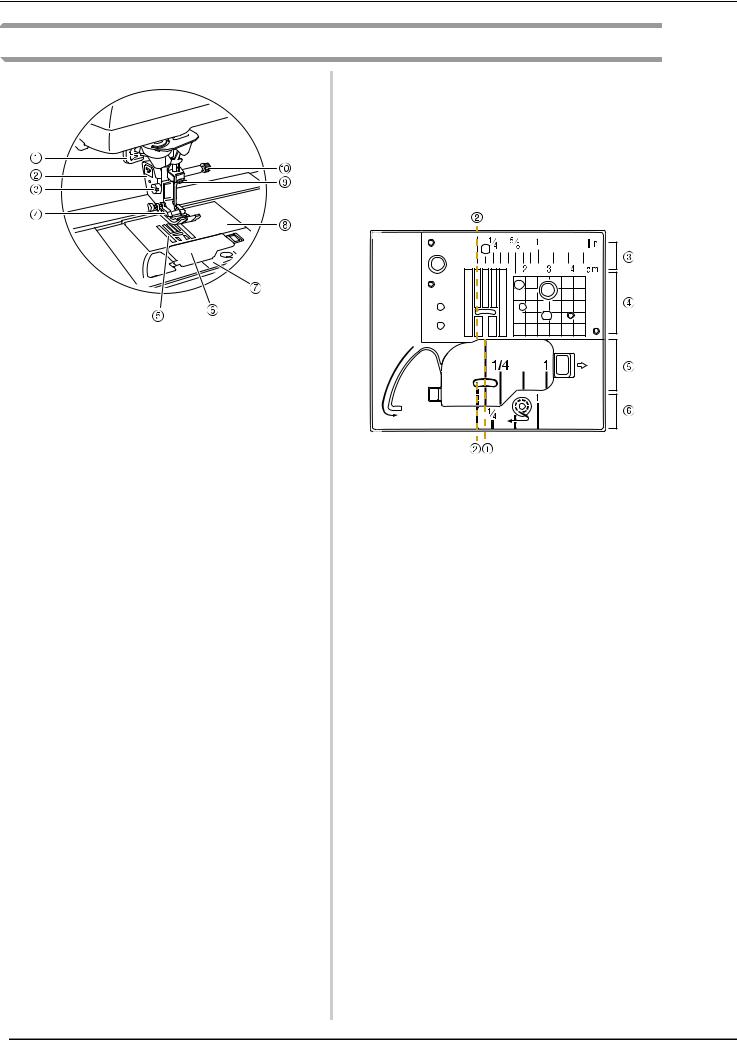
NAMES OF MACHINE PARTS AND THEIR FUNCTIONS
Needle and Presser Foot Section
aButtonhole lever
The buttonhole lever is used with the one-step buttonhole foot to create buttonholes. (page 132)
bPresser foot holder
The presser foot is attached to the presser foot holder. (page 65)
cPresser foot holder screw
Use the presser foot holder screw to hold the presser foot in place. (page 66)
dPresser foot
The presser foot consistently applies pressure to the fabric as sewing takes place. Attach the appropriate presser foot for the selected stitch. (page 65)
eFeed dogs
The feed dogs feed the fabric in the sewing direction.
fBobbin cover
Open the bobbin cover to set the bobbin. (page 54, 103)
gNeedle plate cover
Remove the needle plate cover to clean the race. (page 97, 219)
hNeedle plate
The needle plate is marked with guides to help sew straight seams. (page 96)
iNeedle bar thread guide
Pass the upper thread through the needle bar thread guide. (page 57)
jNeedle clamp screw
Use the needle clamp screw to hold the needle in place. (page 66)
Measurements on the needle plate, bobbin cover (with mark) and needle plate cover
The measurements on the bobbin cover are references for patterns with a middle (center) needle position. The measurements on the needle plate and the needle plate cover are references for stitches with a left needle position.
aFor stitches with a middle (center) needle position
bFor stitches with a left needle position
cLeft needle position on the needle plate <inch>
dLeft needle position on the needle plate <cm>
eMiddle (center) needle position on the bobbin cover (with mark) <inch>
fLeft needle position on the needle plate cover <inch>
14
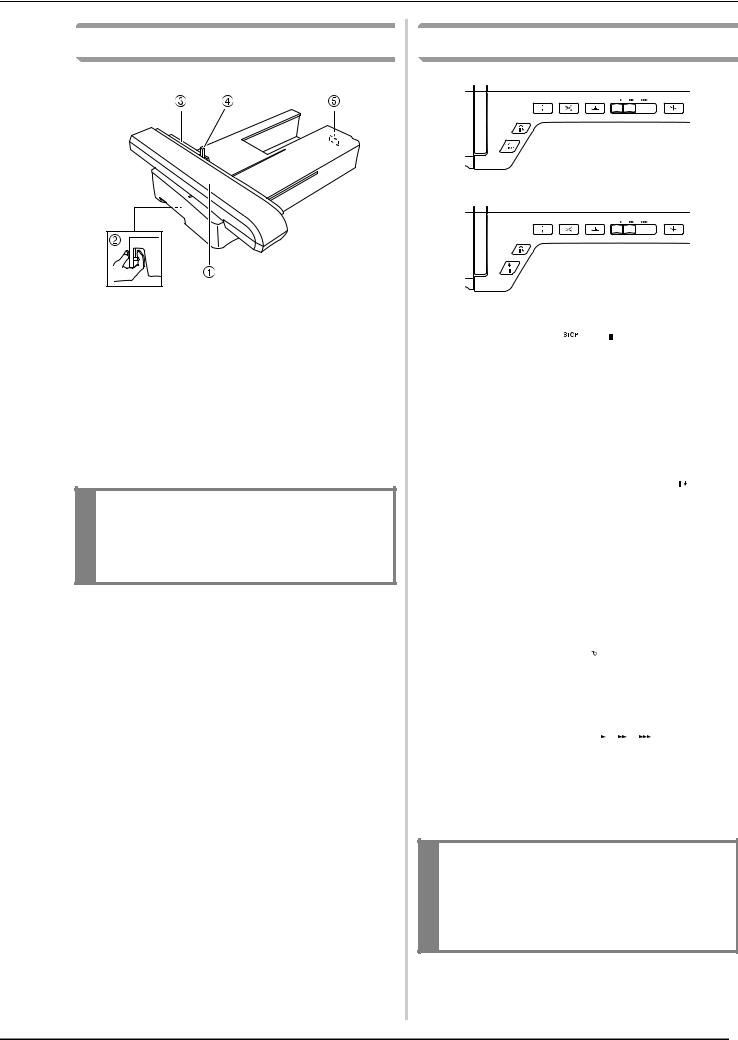
NAMES OF MACHINE PARTS AND THEIR FUNCTIONS
Embroidery Unit
aCarriage
The carriage moves the embroidery frame automatically when embroidering. (page 188)
bRelease button (located under the embroidery unit)
Press the release button to remove the embroidery unit. (page 189)
cEmbroidery frame holder
Insert the embroidery frame into the embroidery frame holder to hold the frame in place. (page 206)
dFrame-securing lever
Press the frame-securing lever down to secure the embroidery frame. (page 206)
eEmbroidery unit connection
Insert the embroidery unit connection into the connection port when attaching the embroidery unit. (page 188)
 CAUTION
CAUTION
•After the embroidery frame is set in the frame holder, be sure the frame-securing lever is correctly lowered.
Operation Buttons
a “Start/Stop” button 

Press this button and the machine will sew a few stitches at a slow speed and then begin sewing at the speed set by the sewing speed controller. Press the button again to stop the machine. Hold the button in to sew at the machine’s slowest speed. The button changes color according to the machine’s operation mode.
Green: |
The machine is ready to sew or is sewing. |
Red: |
The machine cannot sew. |
b“Reverse/Reinforcement Stitch” button 
Use this button to sew reinforcement stitches at the beginning and end of sewing. Press this button, and the machine sews 3 stitches in the same spot and stops automatically. For straight and zigzag stitch patterns that take reverse stitches, the machine will sew reverse stitches at low speed only while holding down the “Reverse/Reinforcement Stitch” button (the stitches are sewn in the opposite direction).
c“Needle Position” button 
Use this button when changing sewing direction or for detailed sewing in small areas. Press this button to raise or lower the needle position. With this button, you can lower and raise the needle to sew a single stitch.
d“Thread Cutter” button 
Press this button after sewing to automatically trim the excess thread.
e“Presser Foot Lifter” button 
Press this button to lower the presser foot and apply pressure to the fabric. Press this button again to raise the presser foot.
fSewing Speed controller 
Use this controller to adjust the sewing speed. Move the slide to the left to sew at slower speeds. Move the slide to the right to sew at higher speeds. Beginners should sew at a slow speed.
g“Automatic Threading” button 
Use this button to automatically thread the needle.
 CAUTION
CAUTION
•Do not press the thread cutter button after the threads have been cut. The needle may break and threads may become tangled, or damage to the machine may occur.
15
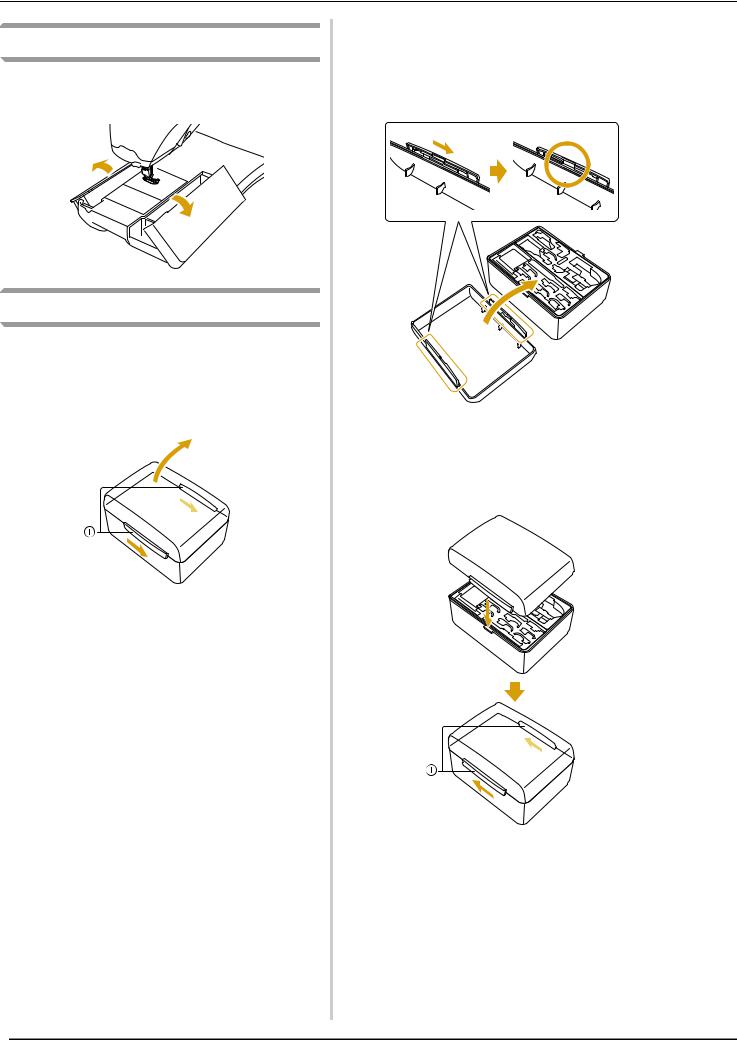
NAMES OF MACHINE PARTS AND THEIR FUNCTIONS
Using the Flat Bed Attachment
Pull the top of the flat bed attachment to open the accessory compartment.
Using the Accessory Case
■ Opening the Accessory Case
Fully slide the bar on each side of the accessory case, and then lift off the lid to open the case.
The case can only be opened or locked correctly if both bars are slid in the same direction.
a Bars
■ Closing the Accessory Case
aFully slide the bar on each side of the accessory case lid to align the notches in the lid with the notches in the bars.
bPlace the lid on top of the case so that the notches in the lid align with the tabs on the case, and then slide the bar on each side back to the center of the accessory case.
a Bars
16

NAMES OF MACHINE PARTS AND THEIR FUNCTIONS
■ Using the Accessory Trays
Two presser foot storage trays are stored in the included accessory case. One is for presser feet for utility sewing, and the other is for presser feet for embroidery and machine quilting.
aFor presser feet for utility sewing
bFor presser feet for embroidery and machine quilting
For your convenience, a presser foot storage tray can be stored in the accessory compartment of the flat bed attachment.
aStorage space of the flat bed attachment
bPresser foot storage space of the flat bed attachment
cPresser foot storage trays
Using the Embroidery Unit
Carrying Case
Included accessories 48-51 are contained in the embroidery unit carrying case. To open the embroidery unit carrying case, raise each lock and move the latches out of position. To re-hook the latches and securely close the case, position the latch on the catch of the unit lid and lower the lock till it snaps.
a
a Latches
Included Accessories
See table on the next page about included accessories.
17
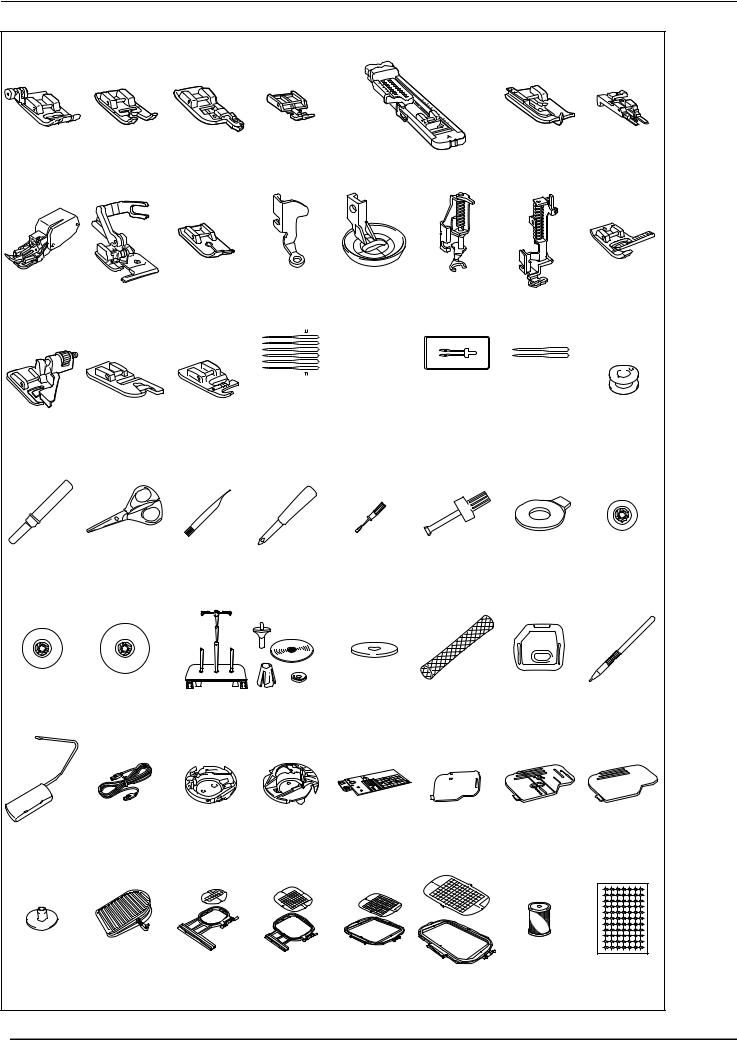
NAMES OF MACHINE PARTS AND THEIR FUNCTIONS
1 |
2 |
3 |
4 |
5 |
6 |
7 |
8 |
9 |
10 |
11 |
12 |
13 |
14 |
15 |
16* |
17* |
18* |
19 |
20 |
21 |
|
22 |
|||||||
|
|
|
|
|
|
|
|
|
|
|
|
|
|
|
|
|
|
|
|
|
|
|
|
|
|
|
|
|
|
|
|
|
|
|
|
|
|
|
|
|
|
|
|
|
|
|
|
|
|
|
|
|
|
|
|
|
|
|
|
|
|
|
75/11 2 needles |
|
2.0/11 needle |
75/11 2needles |
|
|
|
|
90/14 2 needles |
|
|
|
|
|
|
|
90/14 2 needles: |
|
|
|
|
|
|
|
Ball point needle (gold colored) |
|
|
|
|
23 |
24 |
25 |
26 |
27 |
28 |
29 |
30 |
31 |
32 |
33 |
34 |
35 |
36 |
37 |
38 |
39 |
40 |
41 |
42 |
43 |
44 |
45 |
46 |
47 |
48** |
49** |
50** |
51** |
52 |
53 |
*See Additional Accessories Guide for presser feet instructions.
**Included Accessories 48-51 are contained in the embroidery unit carrying case.
18
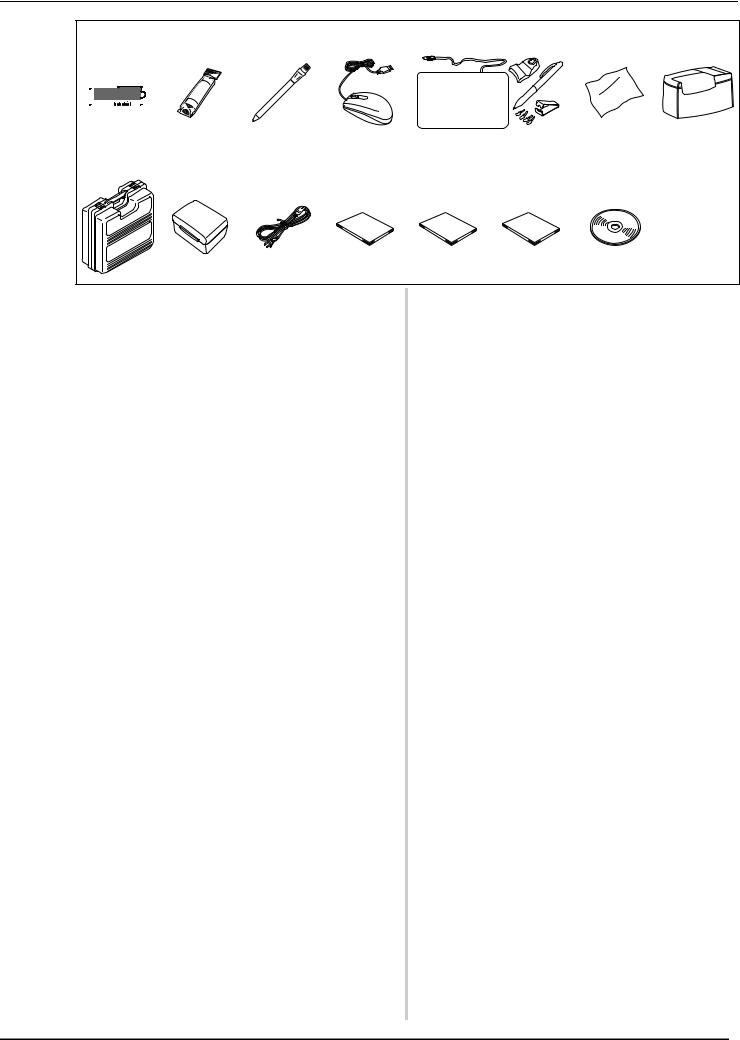
NAMES OF MACHINE PARTS AND THEIR FUNCTIONS
54 |
55 |
56 |
57 |
58 |
59 |
60 |
||||||||
|
|
|
|
|
|
|
|
|
|
|
|
|
|
|
|
|
|
|
|
|
|
|
|
|
|
|
|
|
|
|
|
|
|
|
|
|
|
|
|
|
|
|
|
|
|
|
|
|
|
|
|
|
|
|
|
|
|
|
|
61 |
62 |
63 |
64 |
65 |
66 |
67 |
No. |
Part Name |
Part Code |
|
|
|
1 |
Zigzag foot “J” (on machine) |
XC3021-051 |
|
|
|
2 |
Monogramming foot “N” |
X53840-351 |
|
|
|
3 |
Overcasting foot “G” |
XC3098-051 |
|
|
|
4 |
Zipper foot “I” |
X59370-051 |
|
|
|
5 |
Buttonhole foot “A” |
X57789-151 |
|
|
|
6 |
Blind stitch foot “R” |
X56409-051 |
|
|
|
7 |
Button fitting foot “M” |
130489-001 |
|
|
|
8 |
Walking foot |
X81064-103 |
|
|
|
9 |
Side cutter foot |
XC3198-101 |
|
|
|
10 |
Straight stitch foot |
XD0826-051 |
|
|
|
11 |
Free motion quilting foot “C” |
XE0765-001 |
|
|
|
12 |
Free motion echo quilting foot |
XE0766-001 |
|
“E” |
|
|
|
|
|
|
|
13 |
Free motion open toe quilting |
XE0767-001 |
|
foot “O” |
|
|
|
|
|
|
|
14 |
Embroidery foot “W” |
XC8156-651 |
|
|
|
15 |
Vertical stitch alignment foot |
XE0005-001 |
|
“V” |
|
|
|
|
|
|
|
16 |
Blind stitch foot (with guide)* |
XA0059-001 |
17 |
Narrow hemmer foot* |
184600-001 |
18 |
Cording foot (3 cord guide)* |
XA6871-001 |
19 |
Needle set |
XE4962-001 |
|
|
|
20 |
Twin needle |
XE4963-001 |
|
|
|
21 |
Ball point needle set |
XD0705-051 |
|
|
|
22 |
Bobbin × 10 |
X52800-150 |
|
(One is on machine.) |
|
|
|
|
|
|
|
23 |
Seam ripper |
X54243-001 |
|
|
|
24 |
Scissors |
XC1807-121 |
|
|
|
25 |
Cleaning brush |
X59476-051 |
|
|
|
26 |
Eyelet punch |
135793-001 |
|
|
|
27 |
Screwdriver (small) |
X55468-051 |
|
|
|
28 |
Screwdriver (large) |
XC4237-021 |
|
|
|
29 |
Disc-shaped screwdriver |
XC1074-051 |
|
|
|
30 |
Spool cap (small) |
130013-154 |
|
|
|
31 |
Spool cap (medium) × 2 |
X55260-153 |
|
(One is on machine.) |
|
|
|
|
|
|
|
32 |
Spool cap (large) |
130012-054 |
|
|
|
33 |
Spool stand |
See page 21 |
|
|
|
34 |
Spool felt (on machine) |
X57045-051 |
|
|
|
35 |
Spool net × 2 |
XA5523-050 |
|
|
|
36 |
Embroidery needle plate |
XE5131-001 |
|
cover |
|
|
|
|
|
|
|
37 |
Touch pen (stylus) |
XA9940-051 |
|
|
|
38 |
Knee lifter |
XE4713-001 |
|
|
|
39 |
USB cable |
XD0745-051 |
|
|
|
No. |
Part Name |
Part Code |
|
|
|
40 |
Alternate bobbin case |
XC8167-551 |
|
(no color on the screw) |
|
|
|
|
|
|
|
41 |
Bobbin case |
XE8298-001 |
|
(gray, for bobbin work) |
|
|
|
|
|
|
|
42 |
Straight stitch needle plate |
XE4908-301 |
|
|
|
43 |
Cord guide bobbin cover |
XE8991-001 |
|
(with single hole) |
|
|
|
|
|
|
|
44 |
Bobbin cover (with mark) |
XF0750-001 |
|
(on machine) |
|
|
|
|
|
|
|
45 |
Bobbin cover |
XE8992-001 |
|
|
|
46 |
Bobbin center pin and |
XC8661-251 |
|
instruction sheet |
|
|
|
|
|
|
|
47 |
Foot controller |
XC8028-051 |
|
|
|
48 |
Embroidery frame set (small) |
EF73:Frame |
|
H 2 cm × W 6 cm |
|
|
EF77:Embroidery sheet |
|
|
(H 1 inch × W 2-1/2 inches) |
|
|
|
|
|
|
|
49 |
Embroidery frame set |
EF74:Frame |
|
(medium) H 10 cm × W 10 cm |
|
|
EF78:Embroidery sheet |
|
|
(H 4 inches × W 4 inches) |
|
|
|
|
|
|
|
50 |
Embroidery frame set (quilt) |
EF91:Frame |
|
H 20 cm × W 20 cm |
|
|
EF93:Embroidery sheet |
|
|
(H 8 inches × W 8 inches) |
|
|
|
|
|
|
|
51 |
Embroidery frame set |
|
|
(extra large) |
EF92:Frame |
|
H 30 cm × W 20 cm |
EF94:Embroidery sheet |
|
(H 12 inches × W 8 inches) |
|
|
|
|
52 |
Embroidery bobbin thread |
BBT-W |
|
|
|
53 |
Embroidery positioning |
XE4912-501 |
|
sticker sheets |
|
|
|
|
|
|
|
54 |
Edge sewing sheet × 6 |
XE5500-001 |
|
|
|
55 |
Stabilizer material |
BM3:XE0806-001 |
|
|
|
56 |
Chalk pencil |
XE8568-001 |
|
|
|
57 |
USB mouse |
XE4904-001 |
|
|
|
58 |
Pen tablet |
See page 23 |
|
|
|
59 |
LCD cleaning cloth |
XE5023-001 |
|
|
|
60 |
Soft cover |
XE5112-001 |
|
|
|
61 |
Embroidery unit carrying |
XE3803-001 |
|
case |
|
|
|
|
|
|
|
62 |
Accessory case |
XF0344-001 |
|
|
|
63 |
Power cord |
XC6052-051 |
|
|
|
64 |
Instruction and reference |
XF0252-001 |
|
guide |
|
|
|
|
|
|
|
65 |
Quick reference guide |
XF0347-001 |
|
|
|
66 |
Additional accessories guide |
XF0348-001 |
|
|
|
67 |
On Screen Designer™ CD |
XF0250-001 |
|
|
|
*See Additional Accessories Guide for presser feet instructions.
19
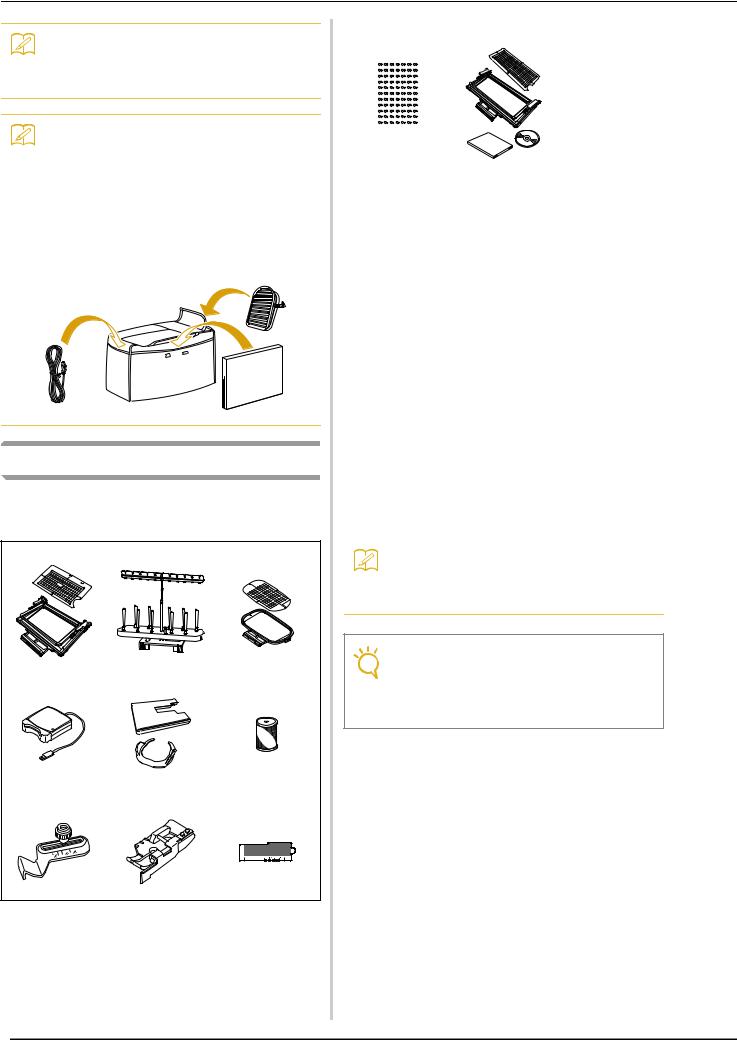
NAMES OF MACHINE PARTS AND THEIR FUNCTIONS
Memo
•Foot controller: Model S
This foot controller can be used on the machine model:BLSOG.
Memo
•Always use accessories recommended for this machine.
•The screw for the presser foot holder is available through your authorized retailer (Part code XA4813-051).
•Included accessories 39, 47, 64, 65 and 66 can be stored in the machine’s soft cover case.
Options
The following are available as optional accessories to be purchased separately.
1 |
2 |
3 |
4 |
5 |
6 |
10 |
11 |
||||||||||
|
|
|
|
|
|
|
|
|
|
|
|
|
|
|
|
|
|
|
|
|
|
|
|
|
|
|
|
|
|
|
|
|
|
|
|
|
|
|
|
|
|
|
|
|
|
|
|
|
|
|
|
|
|
|
|
|
|
|
|
|
|
|
|
|
|
|
|
|
|
|
|
|
|
|
|
|
|
|
|
|
|
|
|
|
|
|
|
|
|
|
|
|
|
|
|
|
|
|
|
|
|
|
|
|
|
|
|
|
|
|
|
|
|
|
|
|
|
|
|
|
|
|
|
|
|
|
|
|
|
|
|
|
|
|
|
|
|
|
|
|
|
|
|
|
|
|
|
|
|
|
|
|
|
|
|
No. |
Part Name |
Part Code |
|
|
|
|
|
1 |
|
Border embroidery frame |
|
|
|
H 18 cm × W 10 cm |
BLSO-BF |
|
|
(H 7 inches × W 4 inches) |
|
|
|
|
|
2 |
|
10 spool stand |
BLSO-TS |
|
|
|
|
3 |
|
Embroidery frame set (large) |
EF75:Frame |
|
|
H 18 cm × W 13 cm |
|
|
|
EF79:Embroidery sheet |
|
|
|
(H 7 inches × W 5 inches) |
|
|
|
|
|
|
|
|
|
4 |
|
Embroidery card Reader |
BLECR |
|
|
|
|
5 |
|
Extension Table and free |
BLSO-ET |
|
|
motion grip |
|
|
|
|
|
|
|
|
|
6 |
|
Embroidery bobbin thread |
BBT-W |
|
|
(white) |
|
|
|
|
|
|
|
|
|
|
|
Embroidery bobbin thread |
BBT-B |
|
|
(black) |
|
|
|
|
|
|
|
|
|
7 |
|
Seam guide |
BLG-SG |
|
|
|
|
8 |
|
1/4 inch piecing foot with |
ESG-QGF |
|
|
guide |
|
|
|
|
|
|
|
|
|
9 |
|
Edge sewing sheet × 5 |
BLSO-ESS |
|
|
|
|
10 |
|
Embroidery positioning |
BLSO-EPS |
|
|
sticker sheets |
|
|
|
|
|
|
|
|
|
11 |
|
Border embroidery frame |
|
|
|
(large) |
|
|
|
H 30 cm × W 10 cm (H 12 |
BLSO-BF2 |
|
|
inches × W 4 inches) |
|
|
|
with Kit 3 upgrade |
|
|
|
|
|
|
|
|
|
Memo
•All specifications are correct at the time of printing. Please be aware that some specifications may change without notice.
Note
•Embroidery cards purchased in foreign countries may not work with your machine.
•Visit your nearest authorized retailer for a complete listing of optional accessories.
7 |
8 |
9 |
20
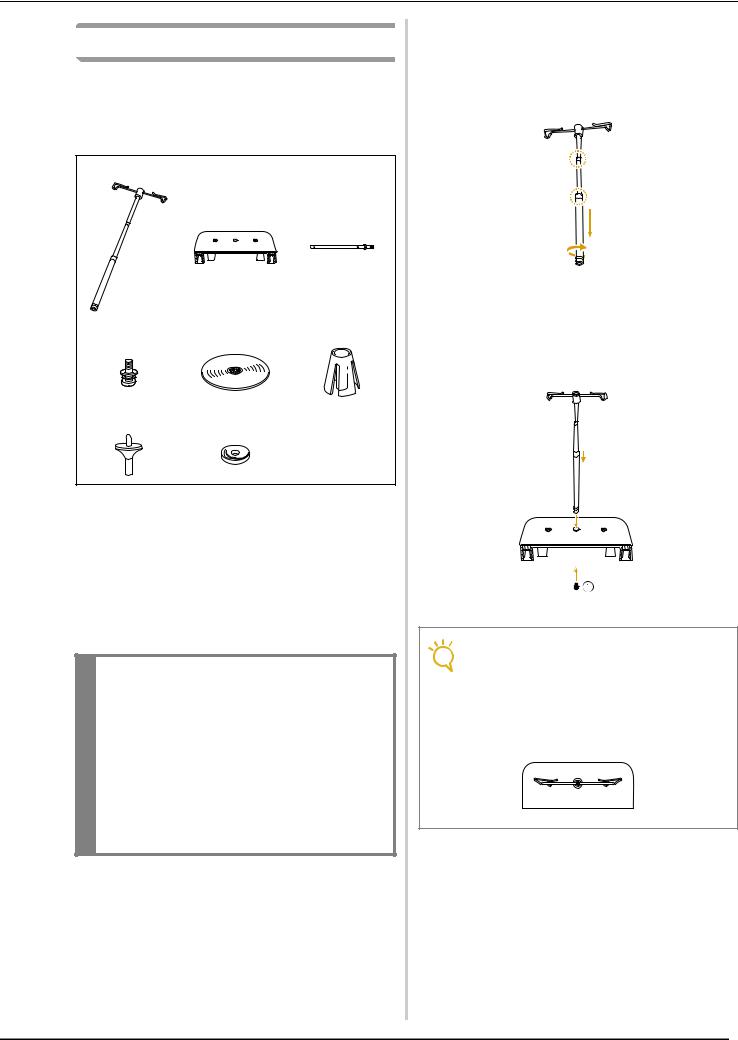
NAMES OF MACHINE PARTS AND THEIR FUNCTIONS
Using the Spool Stand
The included spool stand is useful when using thread spools with a large diameter (cross-wound thread). The spool stand can hold two spools of thread.
1 |
2 |
3 |
4 |
5 |
6 |
7 |
8 |
No. |
Part Name |
Part Code |
|
|
|
1 |
Telescopic thread guide |
XE0776-001 |
|
|
|
2 |
Spool support |
XE4958-001 |
|
|
|
3 |
Spool pin × 2 |
XA6313-051 |
|
|
|
4 |
Screw and washer |
XC7568-051 |
|
|
|
5 |
Spool cap (XL) × 2 |
XE0779-001 |
|
|
|
6 |
Spool holder × 2 |
XA0679-050 |
|
|
|
7 |
Spool cap base × 2 |
XE0780-001 |
|
|
|
8 |
Spool felt × 2 |
XC7134-051 |
|
|
|
 CAUTION
CAUTION
•Do not lift the handle of the machine while the spool stand is installed.
•Do not push or pull the telescopic thread guide or spool pins with extreme force, otherwise damage may result.
•Do not place any object other than spools of thread on the spool support.
•Do not try to wind thread on the bobbin while sewing using the spool stand.
■ How to assemble the spool stand
aFully extend the telescopic thread guide shaft, and then rotate the shaft until the two internal stoppers click into place.
bInsert the telescopic thread guide into the round hole at the center of the spool support, and then use a screwdriver to securely tighten the screw (a) from the reverse side.
a Screw
Note
•Make sure that the stoppers on the telescopic thread guide shaft are firmly in place and that the top of the thread guide is directly above the spool pins. In addition, check that the shaft is securely tightened in the spool support.
21

NAMES OF MACHINE PARTS AND THEIR FUNCTIONS
cFirmly insert the two spool pins into the two holes in the spool support.
dOpen the upper cover of the machine. From the back of the machine, press in the upper cover latches (one on each side), and then pull the upper cover up to remove it from the machine.
eInsert the spool stand onto the notches of the machine.
■ How to remove
aFrom the back of the machine, press in the spool stand latches (one on each side), and then pull the spool stand up to remove it from the machine.
bAttach the upper cover to the machine.
Memo
•See page 52 about the bobbin winding using the spool stand.
•See page 63 about the upper threading using the spool stand.
22
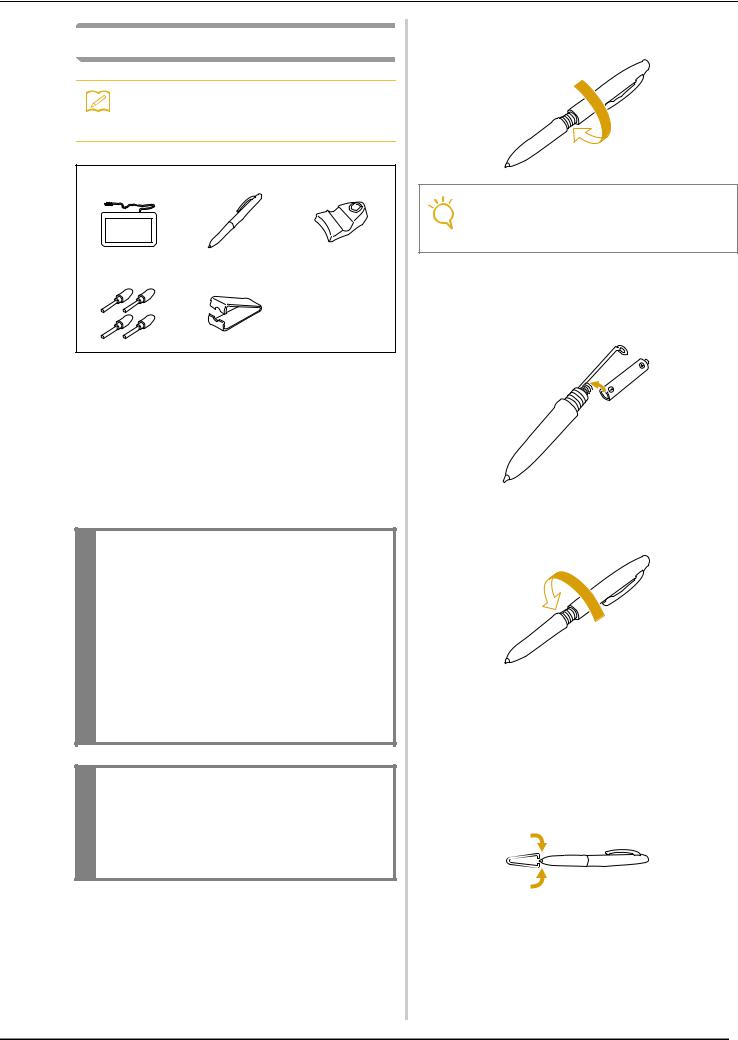
NAMES OF MACHINE PARTS AND THEIR FUNCTIONS
Using the Pen Tablet
Memo
•See page 34 about connecting the pen tablet with the sewing machine.
1 |
2 |
3 |
4 |
5 |
No. |
Part Name |
Part Code |
|
|
|
1 |
Pen tablet |
XF0248-001 |
|
|
|
2 |
Tablet pen |
XF0182-001 |
|
|
|
3 |
Tablet pen holder |
XF0185-001 |
|
|
|
4 |
Extra pen tips (4) |
XF0183-001 |
|
|
|
5 |
Pen tip clip |
XF0184-001 |
|
|
|
■ Installing a battery in the tablet pen
A battery for the tablet pen is not included with your machine. Use a new AAA alkaline battery (LR03).
 WARNING
WARNING
•Do not disassemble or modify the tablet pen/ battery.
•Do not use metallic objects, such as tweezers or a metallic pen, when changing the battery.
•Do not throw the battery into fire or expose to heat.
•Remove battery immediately and stop using the machine if you notice abnormal odor, heat, discoloration, deformation or anything unusual while using or storing it.
 CAUTION
CAUTION
•Remove the battery if you do not intend to use tablet pen for an extended period of time.
•Do not set the positive and negative ends of the battery in the wrong direction.
aUnscrew the upper barrel of the tablet pen.
Note
•Unscrew the upper barrel slowly, so that the tablet pen will not be damaged.
bInstall a new AAA alkaline battery (LR03) in the tablet pen with the positive end (+) pointing up.
cScrew the upper barrel to the tablet pen.
■ Replacing the pen tip
When the pen tip is worn out, replace with a new one included with your pen tablet.
aGrasp the old pen tip firmly with the included pen tip clip.
23
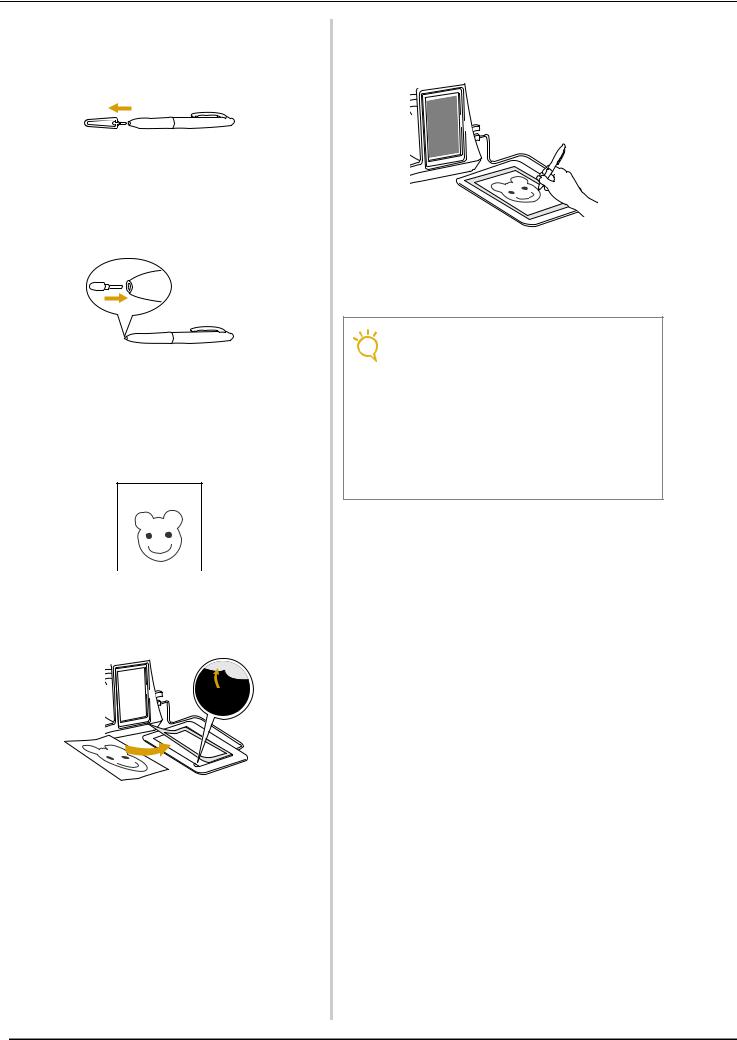
NAMES OF MACHINE PARTS AND THEIR FUNCTIONS
bGently pull the pen tip straight out.
cPush in the new pen tip until it is flush with the tablet pen.
■ Using with On Screen Designer™
aSelect a favorite picture for creating embroidery pattern.
bInsert the picture under the tablet sheet.
cActivate On Screen Designer™, then trace the picture with the tablet pen.
For detailed instructions about operating On Screen Designer™, refer to the Instruction and Reference Guide (PDF format) stored on the On Screen Designer™ CD.
Note
•When you create the embroidery pattern by tracing the picture using the pen tablet, the actual size of the pattern will be bigger than the tracing picture. Check the size of the pattern before embroidering, then change the size of the pattern if needed.
•The pen tablet cannot be used as the USB mouse while tracing the picture. Operate with your finger or touch pen (stylus) while tracing.
24

Chapter 1

 Getting Ready
Getting Ready
TURNING THE MACHINE ON/OFF............... |
26 |
LCD SCREEN................................................... |
28 |
■ Home Page Screen ................................................................... |
28 |
■ Utility Stitch LCD Screen ......................................................... |
29 |
■ Key Functions........................................................................... |
30 |
USB Connectivity.............................................................. |
32 |
■ Using USB Media or Embroidery Card Reader/ |
|
USB Card Writer Module*........................................................ |
32 |
■ Connecting the Machine to the Computer ............................... |
33 |
■ Using a USB Mouse.................................................................. |
33 |
■ Clicking a Key .......................................................................... |
33 |
■ Changing Pages ........................................................................ |
33 |
■ Using the Pen Tablet ................................................................ |
34 |
Using the Machine Setting Mode Key ............................... |
35 |
■ Saving a Settings Screen Image to USB Media.......................... |
39 |
■ Changing the Pointer Shape When a USB Mouse Is Used ........ |
39 |
■ Changing the Screen Saver Image ............................................ |
40 |
■ Selecting the Initial Screen Display .......................................... |
41 |
■ Choosing the Display Language................................................ |
41 |
■ Changing the Background Colors |
|
of the Embroidery Patterns....................................................... |
42 |
■ Specifying the Size of Pattern Thumbnails................................ |
43 |
Using the Sewing Machine Help Key ................................ |
44 |
Using the Operation Guide Function................................ |
45 |
Using the Sewing Guide Function..................................... |
46 |
Using the Pattern Explanation Function............................ |
47 |
LOWER THREADING ..................................... |
48 |
Winding the Bobbin.......................................................... |
48 |
■ Using the Supplemental Spool Pin............................................ |
48 |
■ Using the Spool Pin .................................................................. |
51 |
■ Using the Spool Stand .............................................................. |
52 |
■ Untangling Thread from Beneath the Bobbin Winder Seat....... |
53 |
Setting the Bobbin ............................................................ |
54 |
Pulling Up the Bobbin Thread........................................... |
55 |
UPPER THREADING....................................... |
57 |
Upper Threading............................................................... |
57 |
Using the Twin Needle Mode ........................................... |
60 |
Using the Spool Stand....................................................... |
63 |
■ Using the Spool Stand .............................................................. |
63 |
Using Threads that Unwind Quickly................................. |
64 |
■ Using the Spool Net ................................................................. |
64 |
CHANGING THE PRESSER FOOT .................. |
65 |
Removing the Presser Foot................................................ |
65 |
Attaching the Presser Foot ................................................ |
65 |
Attaching the Walking Foot .............................................. |
66 |
CHANGING THE NEEDLE .............................. |
67 |
About the Needle.............................................................. |
69 |
Fabric/Thread/Needle Combinations................................ |
69 |

TURNING THE MACHINE ON/OFF
TURNING THE MACHINE ON/OFF
 WARNING
WARNING
•Use only regular household electricity for the power source. Using other power sources may result in fire, electric shock, or damage to the machine.
•Make sure that the plugs on the power cord are firmly inserted into the electrical outlet and the power cord receptacle on the machine.
•Do not insert the plug on the power cord into an electrical outlet that is in poor condition.
•Turn the main power to OFF and remove the plug in the following circumstances: When you are away from the machine
After using the machine
When the power fails during use
When the machine does not operate correctly due to a bad connection or a disconnection During electrical storms
 CAUTION
CAUTION
•Use only the power cord included with this machine.
•Do not use extension cords or multi-plug adapters with many other appliances plugged in to them. Fire or electric shock may result.
•Do not touch the plug with wet hands. Electric shock may result.
•When unplugging the machine, always turn the main power to OFF first. Always grasp the plug to remove it from the outlet. Pulling on the cord may damage the cord, or lead to fire or electric shock.
•Do not allow the power cord to be cut, damaged, modified, forcefully bent, pulled, twisted, or bundled. Do not place heavy objects on the cord. Do not subject the cord to heat. These things may damage the cord, or cause fire or electric shock. If the cord or plug is damaged, take the machine to your authorized retailer for repairs before continuing use.
•Unplug the power cord if the machine is not to be used for a long period of time. Otherwise, a fire may result.
•When leaving the machine unattended, either the main switch of the machine should be turned to OFF or the plug must be removed from the socket-outlet.
•When servicing the machine or when removing covers, the machine must be unplugged.
•For U.S.A only
This appliance has a polarized plug (one blade wider than the other). To reduce the risk of electrical shock, this plug is intended to fit in a polarized outlet only one way.
If the plug does not fit fully in the outlet, reverse the plug. If it still does not fit, contact a qualified electrician to install the proper outlet. Do not modify the plug in any way.
26
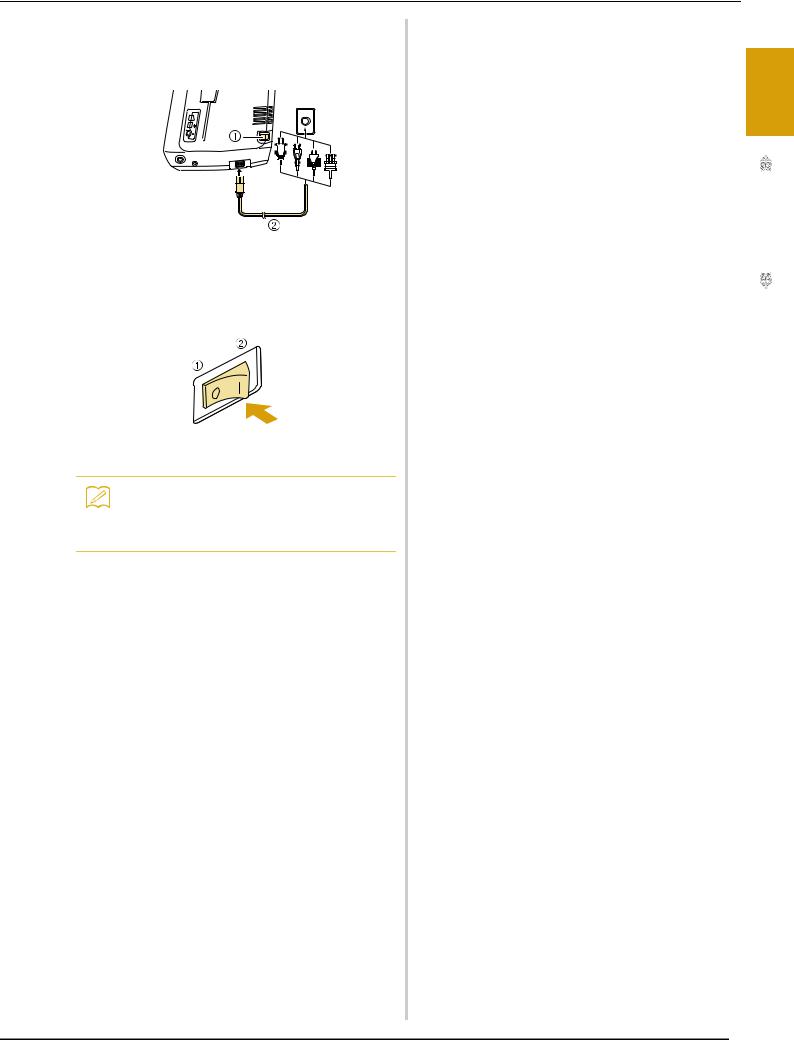
aInsert the power supply cord into the power cord receptacle, then insert the plug into a wall outlet.
aMain power switch
bPower supply cord
bTurn the main power switch to “I” to turn on the machine.
aOFF
bON
Memo
•When the machine is turned on, the needle and the feed dogs will make sound when they move; this is not a malfunction.
cTurn the main power switch to “O” to turn off the machine.
TURNING THE MACHINE ON/OFF
1
Ready Getting
27

LCD SCREEN
LCD SCREEN
When the machine is turned on, the opening movie is played. Touch anywhere on the screen for the home page screen to be displayed. Touch the LCD screen or a key with your finger or the included touch pen to select a machine function.
Note
•When the straight stitch needle plate is on the machine, the needle will automatically move to the middle position.
Memo
•Only touch the screen with your finger or the included touch pen. Do not use a sharp pencil, screwdriver, or other hard or sharp object. It is not necessary to press hard on the screen. Pressing too hard or using a sharp object may damage the screen.
■Home Page Screen
a
b
c
No. |
Display |
Key Name |
Explanation |
Page |
|
|
|
|
|
a |
|
Sewing key |
Press this key to sew utility stitches or character or decorative stitch |
See the “Key |
|
|
|
patterns. |
Functions” table. |
|
|
|
|
30 |
|
|
|
|
|
b |
|
Embroidery key |
Attach the embroidery unit and press this key to embroider patterns. |
186 |
|
|
|
|
|
c |
|
Embroidery Edit key |
Press this key to combine embroidery patterns. With the embroidery |
264 |
|
|
|
edit functions, you can also create original embroidery patterns or frame |
|
|
|
|
patterns. |
|
|
|
|
|
|
28
